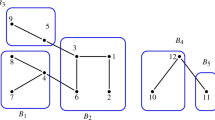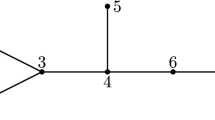Abstract
In this paper we introduce and characterize two new values for cooperative transferable utility games with graph restricted communication and a priori unions. Both values are obtained by applying the Shapley value to an associated TU-game. The graph-partition restricted TU-game is obtained by taking the Myerson graph restricted game, and of that the Kamijo partition restricted game. In this game the dividend of any coalition that is neither a subset of a union nor a union of unions is zero. The partition-graph restricted TU-game is obtained by taking the partition restricted game, and of that the graph restricted game. In this game the dividend of any coalition that is not connected in the graph is zero. We apply the values to an economic example in which the players in a union represent the cities in a country and the graph represents a network of natural gas pipelines between the cities.


Similar content being viewed by others
Notes
Shapley (1953) describes a value as providing for each player an a priori assessment of the utility of becoming involved in a game.
The (Harsanyi) dividend of a coalition is the additional contribution of cooperation among the players in a coalition, that they did not already realize by cooperating in smaller coalitions, see Harsanyi (1963).
Note that Myerson (1980) defined balanced contributions for conference structures on a fixed player set. In his model, instead of a player leaving the game, all feasible coalitions containing this player are no longer feasible but, by definition, the player stays connected as a singleton.
Although it is easy to formulate balanced contributions for a fixed player set, it is more difficult to state collective balanced contributions on a fixed player set since we need to specify how the players in \(P_h\) ‘stay’ in the game. Therefore, these axioms are more different than their name might suggest.
This follows similar as shown in Myerson (1980) for a fixed player set.
Note that any solution for TU-games with graph and coalition structure that satisfies component efficiency, also satisfies graph efficiency.
Since the values of Alonso-Meijide et al. (2009) are not efficient, these values are not included in the table.
References
Alonso-Meijide JM, Álvarez-Mozos M, Fiestras-Janeiro MG (2009) Values of games with graph restricted communication and a priori unions. Math Soc Sci 58:202–213
Ambec S, Sprumont Y (2002) Sharing a river. J Econ Theory 107:453–462
Aumann RJ, Drèze JH (1974) Cooperative games with coalition structures. Int J Game Theory 3:217–237
Banzhaf JF (1965) Weighted voting does not work: a mathematical analysis. Rutgers Law Rev 19:317–343
van den Brink JR, van der Laan G, Moes N (2012) Fair agreements for sharing international rivers with multiple springs and externalities. J Environ Econ Manag 63:388–403
Harsanyi JC (1963) A simplified bargaining model for the \(n\)-person cooperative game. Int Econ Rev 4:194–220
Kamijo Y (2013) The collective value: a new solution for games with coalition structures. TOP 21:572–589
Khmelnitskaya AB (2013) Values for games with two-level communication structures. Discrete Appl Math. doi:10.1016/j.dam.2013.10.019
Kongo T (2011) Value of games with two-layered hypergraphs. Math Soc Sci 62:114–119
Myerson RB (1977) Graphs and cooperation in games. Math Oper Res 2:225–229
Myerson RB (1980) Conference structures and fair allocation rules. Int J Game Theory 9:169–182
von Neumann J, Morgenstern O (1944) Theory of games and economic behavior. Princeton University Press, Princeton
Owen G (1977) Values of games with a priori unions. In: Henn R, Moeschlin O (eds) Mathematical economics and game theory. Springer, Berlin, pp 76–88
Owen G (1986) Values of graph-restricted games. SIAM J Algebr Discrete Methods 7:210–220
Shapley LS (1953) A value for \(n\)-person games. In: Kuhn HW, Tucker AW (eds) Contributions to the theory of games, vol II. Princeton University Press, Princeton, pp 307–317
Vázquez-Brage M, García-Jurado I, Carreras F (1996) The Owen value applied to games with graph-restricted communication. Games Econ Behav 12:42–53
Author information
Authors and Affiliations
Corresponding author
Additional information
This research is financially supported by Netherlands Organization for Scientific Research, NWO Grant 400-07-159. We thank a referee for useful comments.
Rights and permissions
About this article
Cite this article
van den Brink, R., van der Laan, G. & Moes, N. Values for transferable utility games with coalition and graph structure. TOP 23, 77–99 (2015). https://doi.org/10.1007/s11750-014-0324-1
Received:
Accepted:
Published:
Issue Date:
DOI: https://doi.org/10.1007/s11750-014-0324-1




